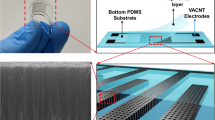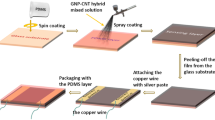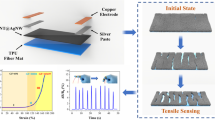Abstract
Devices made from stretchable electronic materials could be incorporated into clothing or attached directly to the body. Such materials have typically been prepared by engineering conventional rigid materials such as silicon, rather than by developing new materials. Here, we report a class of wearable and stretchable devices fabricated from thin films of aligned single-walled carbon nanotubes. When stretched, the nanotube films fracture into gaps and islands, and bundles bridging the gaps. This mechanism allows the films to act as strain sensors capable of measuring strains up to 280% (50 times more than conventional metal strain gauges), with high durability, fast response and low creep. We assembled the carbon-nanotube sensors on stockings, bandages and gloves to fabricate devices that can detect different types of human motion, including movement, typing, breathing and speech.
This is a preview of subscription content, access via your institution
Access options
Subscribe to this journal
Receive 12 print issues and online access
$259.00 per year
only $21.58 per issue
Buy this article
- Purchase on Springer Link
- Instant access to full article PDF
Prices may be subject to local taxes which are calculated during checkout




Similar content being viewed by others
References
Khang, D. Y., Jiang, H., Huang, Y. & Rogers, J. A. A stretchable form of single-crystal silicon for high-performance electronics on rubber substrates. Science 311, 208–212 (2006).
Kim, D. H. et al. Stretchable and foldable silicon integrated circuits. Science 320, 507–511 (2008).
Kim, D. H. & Rogers, J. A. Stretchable electronics: materials strategies and devices. Adv. Mater. 20, 4887–4892 (2008).
Someya, T. et al. Conformable, flexible, large-area networks of pressure and thermal sensors with organic transistor active matrixes. Proc. Natl Acad. Sci. USA 102, 12321–12325 (2005).
Sekitani, T. et al. A rubberlike stretchable active matrix using elastic conductors. Science 321, 1468–1472 (2008).
Sekitani, T. et al. Stretchable active-matrix organic light-emitting diode display using printable elastic conductors. Nature Mater. 8, 494–499 (2009).
Urdaneta, M. G., Delille, R. & Smela, E. Stretchable electrodes with high conductivity and photo-patternability. Adv. Mater. 19, 2629–2633 (2007).
Mattmann, C., Clemens, F. & Tröster, G. Sensor for measuring strain in textile. Sensors 8, 3719–3732 (2008).
Munro, B. J., Campbell, T. E., Wallace, G. G. & Steele, J. R. The intelligent knee sleeve: a wearable biofeedback device. Sens. Actuat. B 131, 541–547 (2008).
Scilingo, E. P., Lorussi, F., Mazzoldi, A. & Rossi, D. D. Strain-sensing fabrics for wearable kinaesthetic-like systems. IEEE Sens. J. 3, 460–467 (2003).
Cochrane, C., Koncar, V., Lewandowski, M. & Dufour, C. Design and development of a flexible strain sensor for textile structures based on a conductive polymer composite. Sensors 7, 473–492 (2007).
Lacour, S. P., Jones, J., Wagner, S., Li, T. & Suo, Z. G. Stretchable interconnects for elastic electronic surfaces. Proc. IEEE 93, 1459–1467 (2005).
Hata, K. et al. Water-assisted highly efficient synthesis of impurity-free single-walled carbon nanotubes. Science 306, 1362–1364 (2004).
Futaba, D. N. et al. Shape-engineerable and highly densely packed single-walled carbon nanotubes and their application as super-capacitor electrodes. Nature Mater. 5, 987–994 (2006).
Hayamizu, Y. et al. Integrated three-dimensional microelectromechanical devices from processable carbon nanotube wafers. Nature Nanotech. 3, 289–294 (2008).
Dobie, W. B. & Isaac Peter, C. G. Electric Resistance Strain Gauges (English Universities Press Limited, 1948).
Shin, M. K. et al. Elastomeric conductive composites based on carbon nanotube forests. Adv. Mater. 22, 2663–2667 (2010).
Qiang, L. et al. Improved electrical resistance–pressure strain sensitivity of carbon nanotube network/polydimethylsiloxane composite using filtration and transfer process. Chin. Sci. Bull. 55, 326–330 (2010).
Fleming, P. J. et al. Interaction between bedding and sleeping position in the sudden infant death syndrome: a population based case-control study. Br. Med. J. 301, 85–89 (1990).
Nikitczuk, J., Weinberg, B. & Mavroidis, C. Control of electro-rheological fluid based resistive torque elements for use in active rehabilitation devices. Smart Mater. Struct. 16, 418–428 (2007).
Dipietro, L., Sabatini, A. M. & Dario, P. A survey of glove-based systems and their applications. IEEE Trans. Syst. Man. Cybern. 38, 461–482 (2008).
Hanly, E. J. & Talamini, M. A. Robotic abdominal surgery. Am. J. Surg. 188, 19S–26S (2004).
Wojtara, T. et al. Hydraulic master–slave land mine clearance robot hand controlled by pulse modulation. Mechatronics 15, 589–609 (2005).
Picard, R. W. & Healey, J. Affective wearables. Pers. Ubiquitous Comput. 1, 231–240 (1997).
Acknowledgements
The authors thank Y. Yamada and T. Toida for their assistance. The authors also acknowledge partial support from Core Research for Evolutional Science and Technology (CREST) of the Japan Science and Technology Agency (JST).
Author information
Authors and Affiliations
Contributions
T.Y., Y.H. and K.H. conceived and designed the experiments. T.Y. and Yu.Y. performed the experiments. D.F. contributed to materials preparation, Yo.Y. and A.I. contributed to device demonstration. T.Y. and K.H. co-wrote the paper.
Corresponding author
Ethics declarations
Competing interests
The authors declare no competing financial interests.
Supplementary information
Supplementary information
Supplementary information (PDF 1613 kb)
Supplementary information
Supplementary movie 1 (MOV 3297 kb)
Supplementary information
Supplementary movie 2 (MOV 1021 kb)
Supplementary information
Supplementary movie 3 (MOV 3295 kb)
Rights and permissions
About this article
Cite this article
Yamada, T., Hayamizu, Y., Yamamoto, Y. et al. A stretchable carbon nanotube strain sensor for human-motion detection. Nature Nanotech 6, 296–301 (2011). https://doi.org/10.1038/nnano.2011.36
Received:
Accepted:
Published:
Issue Date:
DOI: https://doi.org/10.1038/nnano.2011.36
This article is cited by
-
Structure driven piezoresistive performance design for rubbery composites-based sensors and application prospect: a review
Acta Mechanica Sinica (2024)
-
Fabrication Techniques and Sensing Mechanisms of Textile-Based Strain Sensors: From Spatial 1D and 2D Perspectives
Advanced Fiber Materials (2024)
-
Optical \(\varvec{\nu }\)-conformable normalized and recursional electroosmotic optimistic \(\varvec{\nu }\)-conformable energy
Optical and Quantum Electronics (2024)
-
Structure, principle and performance of flexible conductive polymer strain sensors: a review
Journal of Materials Science: Materials in Electronics (2024)
-
Real-time finger motion recognition using skin-conformable electronics
Nature Electronics (2023)



